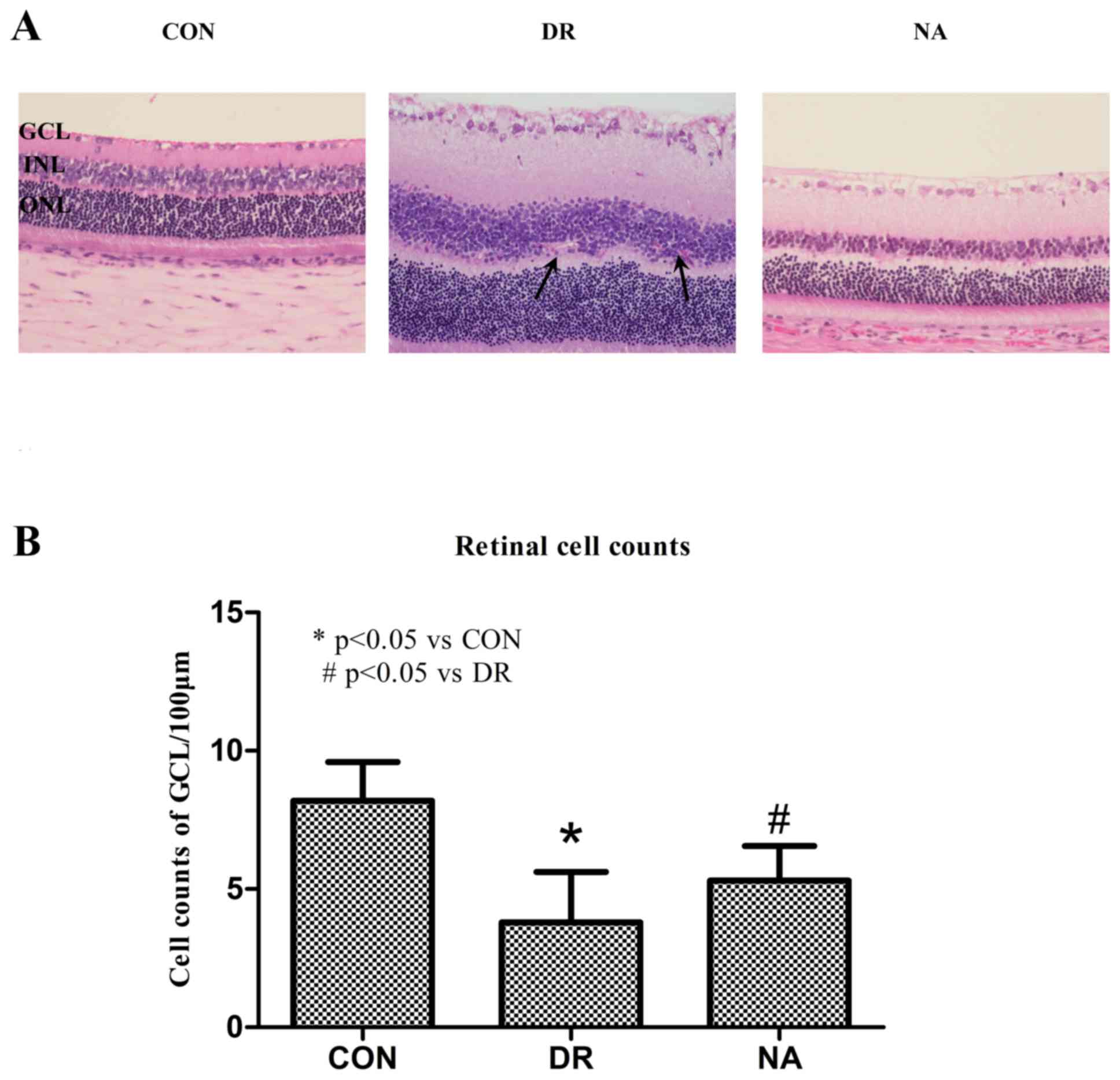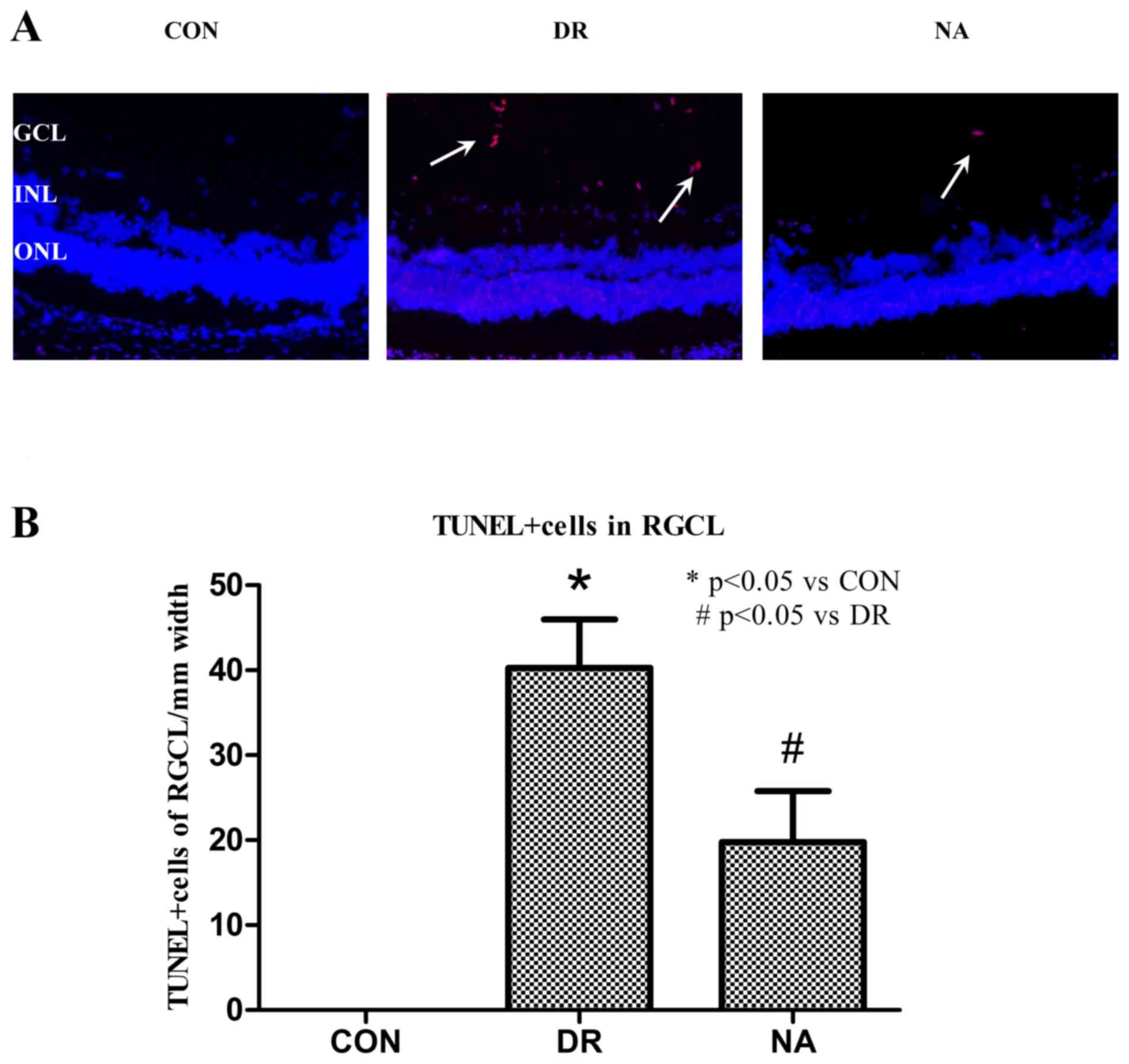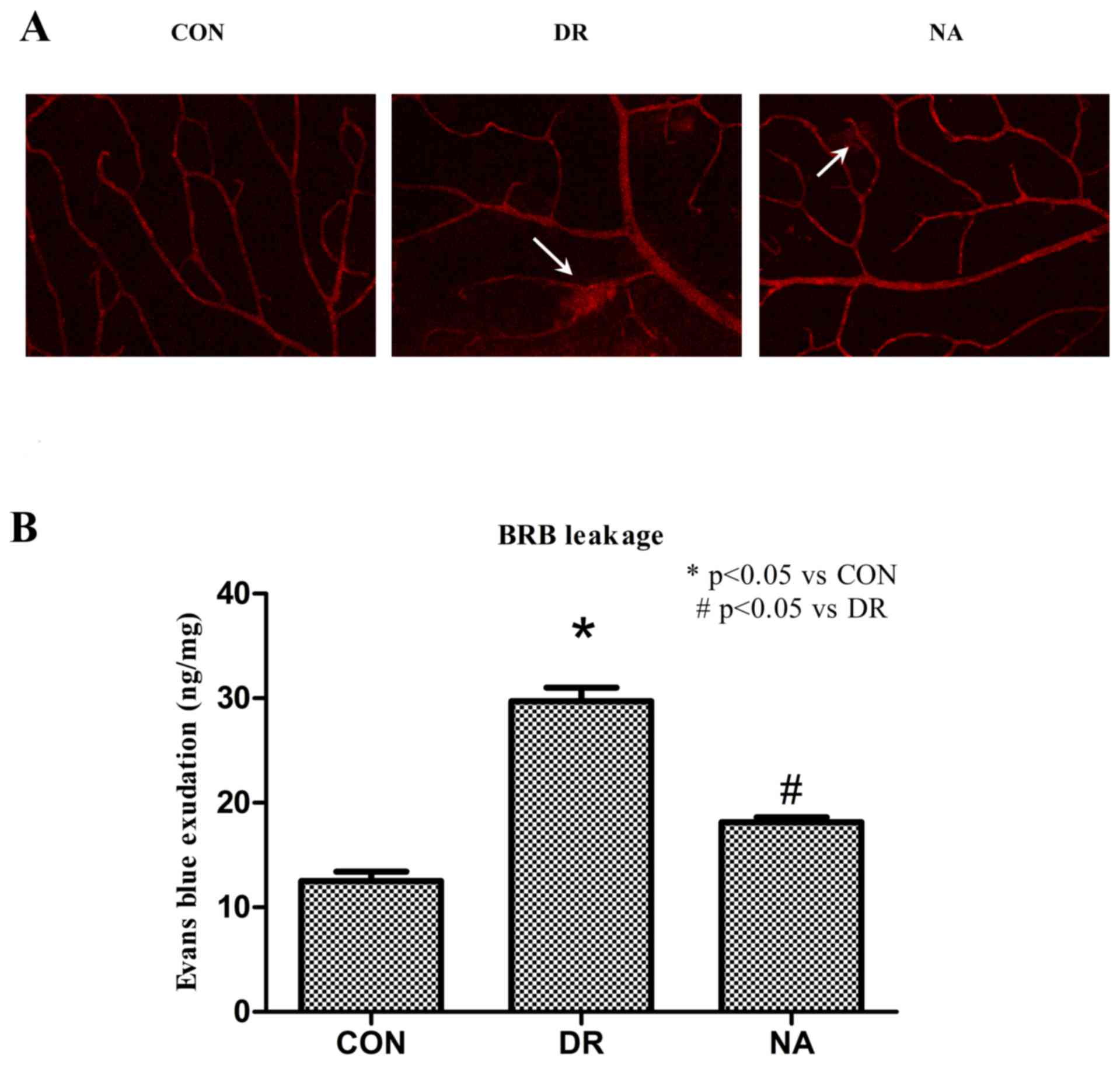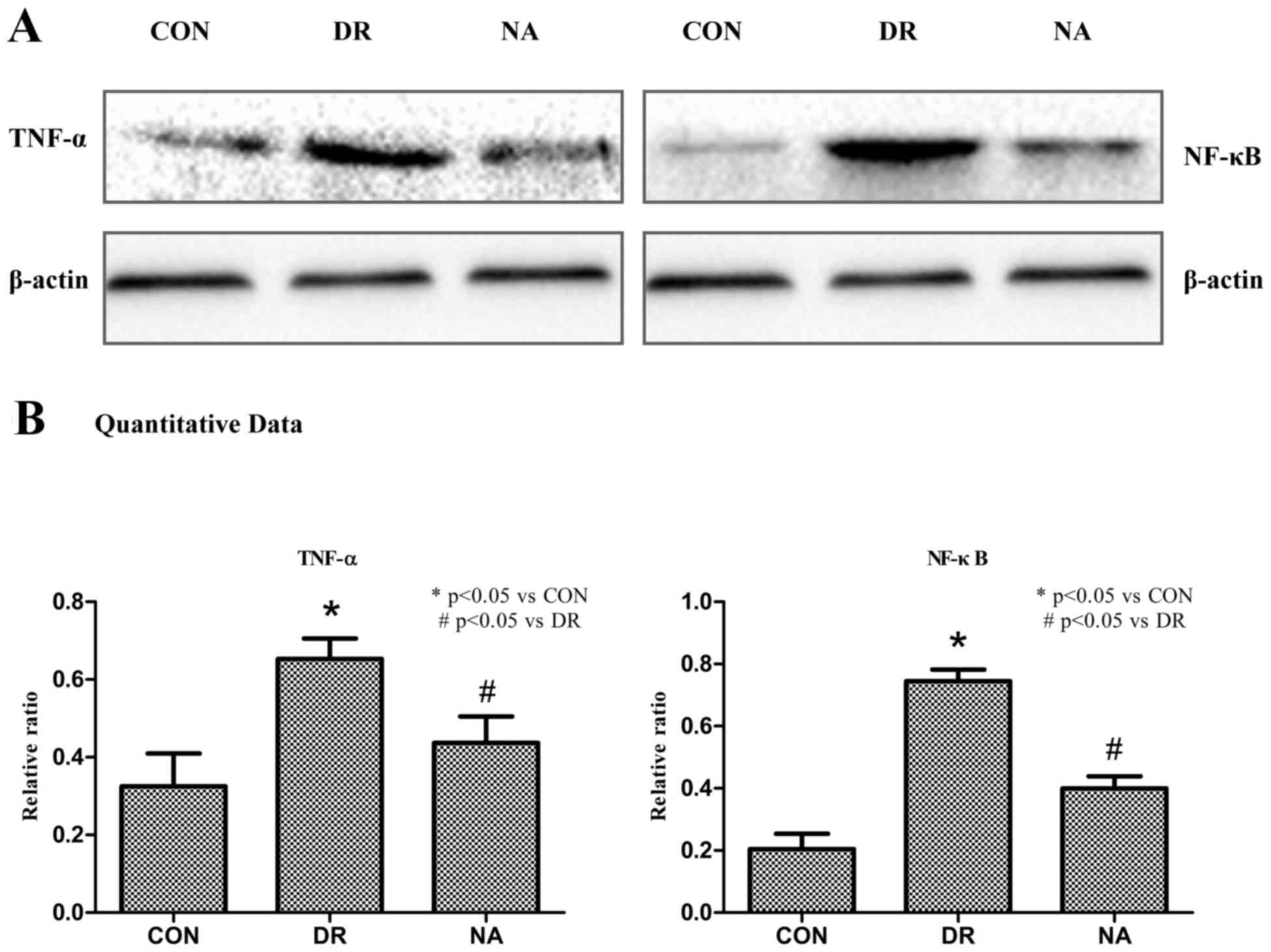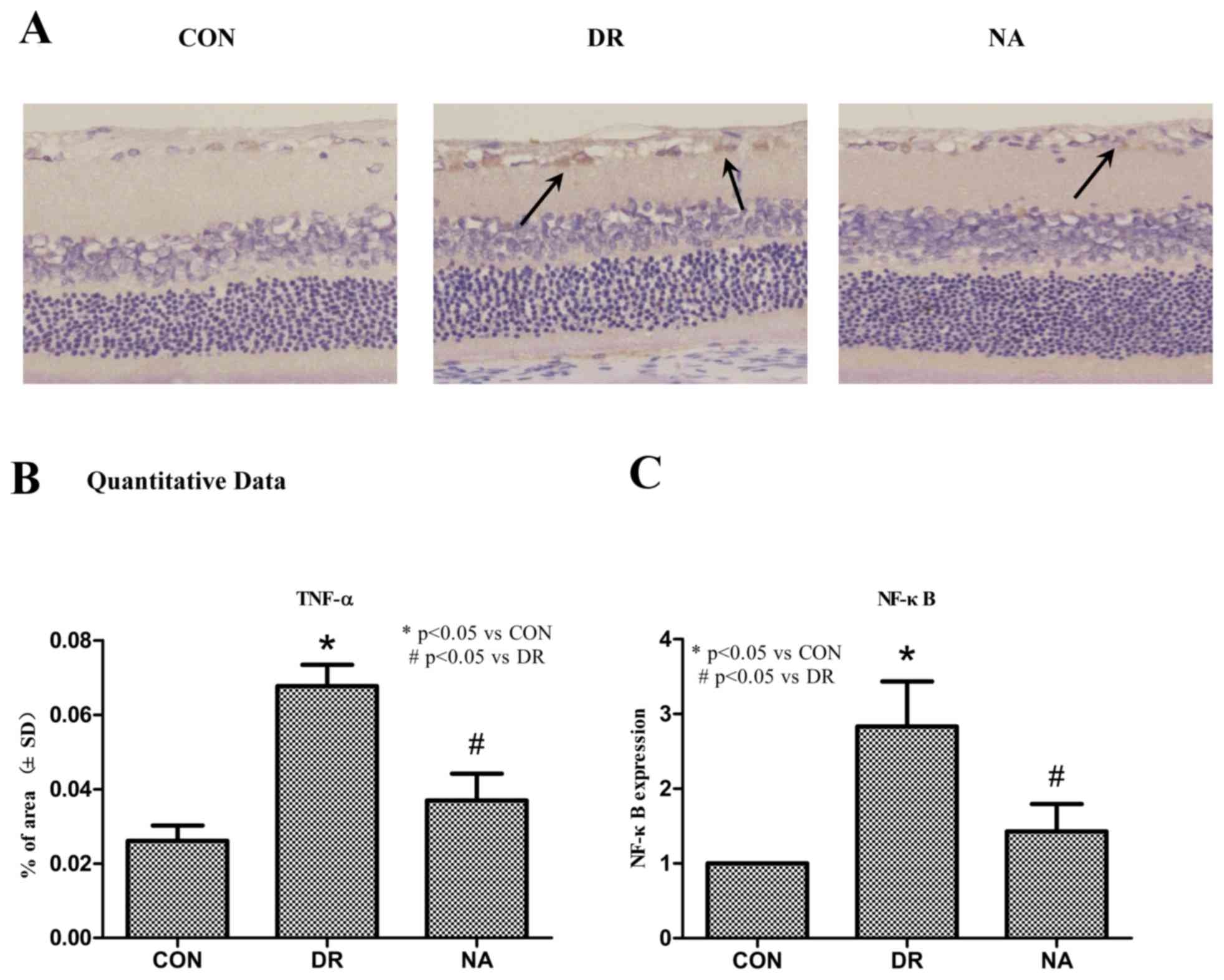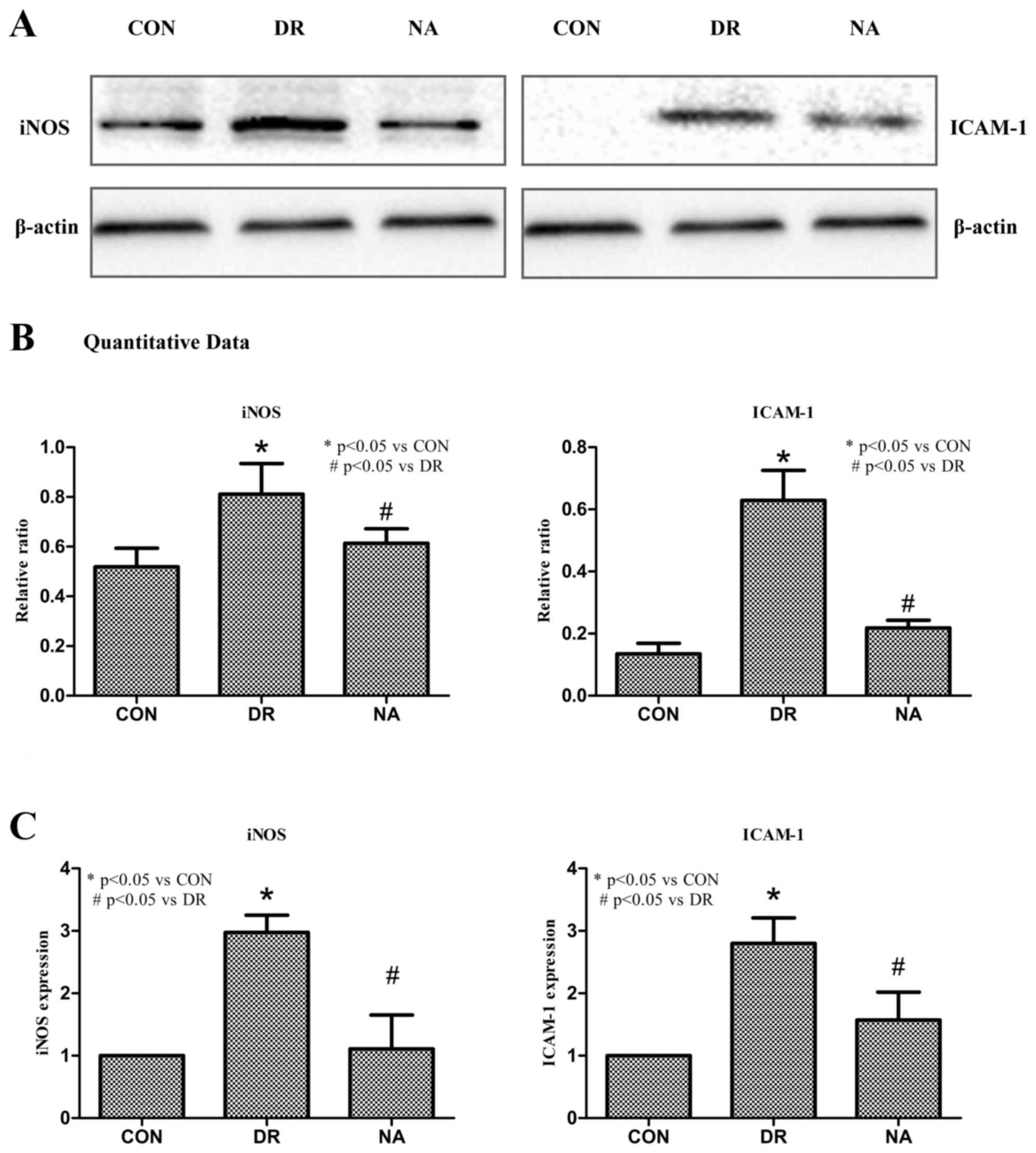|
1
|
Aiello LP, Gardner TW, King GL,
Blankenship G, Cavallerano JD, Ferris FL III and Klein R: Diabetic
retinopathy. Diabetes Care. 21:143–156. 1998. View Article : Google Scholar : PubMed/NCBI
|
|
2
|
Stem MS and Gardner TW: Neurodegeneration
in the pathogenesis of diabetic retinopathy: Molecular mechanisms
and therapeutic implications. Curr Med Chem. 20:3241–3250. 2013.
View Article : Google Scholar : PubMed/NCBI
|
|
3
|
Abcouwer SF: Angiogenic factors and
cytokines in diabetic retinopathy. J Clin Cell Immunol. (Suppl 1).
2013.PubMed/NCBI
|
|
4
|
Chapman MJ, Assmann G, Fruchart JC,
Shepherd J and Sirtori C: European Consensus Panel on HDL-C:
Raising high-density lipoprotein cholesterol with reduction of
cardiovascular risk: The role of nicotinic acid-a position paper
developed by the European Consensus Panel on HDL-C. Curr Med Res
Opin. 20:1253–1268. 2004. View Article : Google Scholar : PubMed/NCBI
|
|
5
|
Elam MB, Hunninghake DB, Davis KB, Garg R,
Johnson C, Egan D, Kostis JB, Sheps DS and Brinton EA: Effect of
niacin on lipid and lipoprotein levels and glycemic control in
patients with diabetes and peripheral arterial disease: The ADMIT
study: A randomized trial. Arterial Disease Multiple Intervention
Trial. JAMA. 284:1263–1270. 2000. View Article : Google Scholar : PubMed/NCBI
|
|
6
|
Heemskerk MM, Dharuri HK, van den Berg SA,
Jónasdóttir HS, Kloos DP, Giera M, van Dijk KW and van Harmelen V:
Prolonged niacin treatment leads to increased adipose tissue PUFA
synthesis and anti-inflammatory lipid and oxylipin plasma profile.
J Lipid Res. 55:2532–2540. 2014. View Article : Google Scholar : PubMed/NCBI
|
|
7
|
Si Y, Zhang Y, Zhao J, Guo S, Zhai L, Yao
S, Sang H, Yang N, Song G, Gu J and Qin S: Niacin inhibits vascular
inflammation via downregulating nuclear transcription factor-κB
signaling pathway. Mediators Inflamm. 2014:2637862014. View Article : Google Scholar : PubMed/NCBI
|
|
8
|
Zhang W and Yan H: Simvastatin increases
circulating endothelial progenitor cells and reduces the formation
and progression of diabetic retinopathy in rats. Exp Eye Res.
105:1–8. 2012. View Article : Google Scholar : PubMed/NCBI
|
|
9
|
Lei S, Li H, Xu J, Liu Y, Gao X, Wang J,
Ng KF, Lau WB, Ma XL, Rodrigues B, et al: Hyperglycemia-induced
protein kinase C β2 activation induces diastolic cardiac
dysfunction in diabetic rats by impairing caveolin-3 expression and
Akt/eNOS signaling. Diabetes. 62:2318–2328. 2013. View Article : Google Scholar : PubMed/NCBI
|
|
10
|
Livak KJ and Schmittgen TD: Analysis of
relative gene expression data using real-time quantitative PCR and
the 2(−Delta Delta C (T)) Method. Methods. 25:402–408. 2001.
View Article : Google Scholar : PubMed/NCBI
|
|
11
|
Arden GB and Sivaprasad S: The
pathogenesis of early retinal changes of diabetic retinopathy. Doc
Ophthalmol. 124:15–26. 2012. View Article : Google Scholar : PubMed/NCBI
|
|
12
|
Barber AJ, Lieth E, Khin SA, Antonetti DA,
Buchanan AG and Gardner TW: Neural apoptosis in the retina during
experimental and human diabetes. Early onset and effect of insulin.
J Clin Invest. 102:783–791. 1998. View
Article : Google Scholar : PubMed/NCBI
|
|
13
|
Joussen AM, Doehmen S, Le ML, Koizumi K,
Radetzky S, Krohne TU, Poulaki V, Semkova I and Kociok N: TNF-alpha
mediated apoptosis plays an important role in the development of
early diabetic retinopathy and long-term histopathological
alterations. Mol Vis. 15:1418–1428. 2009.PubMed/NCBI
|
|
14
|
Joussen AM, Poulaki V, Le ML, Koizumi K,
Esser C, Janicki H, Schraermeyer U, Kociok N, Fauser S, Kirchhof B,
et al: A central role for inflammation in the pathogenesis of
diabetic retinopathy. FASEB J. 18:1450–1452. 2004.PubMed/NCBI
|
|
15
|
Krady JK, Basu A, Allen CM, Xu Y, LaNoue
KF, Gardner TW and Levison SW: Minocycline reduces proinflammatory
cytokine expression, microglial activation, and caspase-3
activation in a rodent model of diabetic retinopathy. Diabetes.
54:1559–1565. 2005. View Article : Google Scholar : PubMed/NCBI
|
|
16
|
Mukhopadhyay S, Hoidal JR and Mukherjee
TK: Role of TNFalpha in pulmonary pathophysiology. Respir Res.
7:1252006. View Article : Google Scholar : PubMed/NCBI
|
|
17
|
el Abu Asrar AM, Maimone D, Morse PH,
Gregory S and Reder AT: Cytokines in the vitreous of patients with
proliferative diabetic retinopathy. Am J Ophthalmol. 114:731–736.
1992. View Article : Google Scholar : PubMed/NCBI
|
|
18
|
Joussen AM, Poulaki V, Mitsiades N,
Kirchhof B, Koizumi K, Döhmen S and Adamis AP: Nonsteroidal
anti-inflammatory drugs prevent early diabetic retinopathy via
TNF-alpha suppression. FASEB J. 16:438–440. 2002.PubMed/NCBI
|
|
19
|
Vinores SA, Xiao WH, Shen J and
Campochiaro PA: TNF-alpha is critical for ischemia-induced
leukostasis, but not retinal neovascularization nor VEGF-induced
leakage. J Neuroimmunol. 182:73–79. 2007. View Article : Google Scholar : PubMed/NCBI
|
|
20
|
Jiang Y, Zhang Q, Soderland C and Steinle
JJ: TNFα and SOCS3 regulate IRS-1 to increase retinal endothelial
cell apoptosis. Cell Signal. 24:1086–1092. 2012. View Article : Google Scholar : PubMed/NCBI
|
|
21
|
Sun X, Han F, Yi J, Han L and Wang B:
Effect of aspirin on the expression of hepatocyte NF-κB and serum
TNF-α in streptozotocin-induced type 2 diabetic rats. J Korean Med
Sci. 26:765–770. 2011. View Article : Google Scholar : PubMed/NCBI
|
|
22
|
Takeda K, Kermani P, Anastasia A, Obinata
Y, Hempstead BL and Kurihara H: BDNF protects human vascular
endothelial cells from TNFα-induced apoptosis. Biochem Cell Biol.
91:341–349. 2013. View Article : Google Scholar : PubMed/NCBI
|
|
23
|
Gao JJ, Hu YW, Wang YC, Sha YH, Ma X, Li
SF, Zhao JY, Lu JB, Huang C, Zhao JJ, et al: ApoM suppresses
TNF-α-induced expression of ICAM-1 and VCAM-1 through inhibiting
the activity of NF-κB. DNA Cell Biol. 34:550–556. 2015. View Article : Google Scholar : PubMed/NCBI
|
|
24
|
Kern TS: Contributions of inflammatory
processes to the development of the early stages of diabetic
retinopathy. Exp Diabetes Res. 2007:951032007. View Article : Google Scholar : PubMed/NCBI
|
|
25
|
Ellis EA, Guberski DL, Hutson B and Grant
MB: Time course of NADH oxidase, inducible nitric oxide synthase
and peroxynitrite in diabetic retinopathy in the BBZ/WOR rat.
Nitric Oxide. 6:295–304. 2002. View Article : Google Scholar : PubMed/NCBI
|
|
26
|
El-Asrar Abu AM, Desmet S, Meersschaert A,
Dralands L, Missotten L and Geboes K: Expression of the inducible
isoform of nitric oxide synthase in the retinas of human subjects
with diabetes mellitus. Am J Ophthalmol. 132:551–556. 2001.
View Article : Google Scholar : PubMed/NCBI
|
|
27
|
Leal EC, Manivannan A, Hosoya K, Terasaki
T, Cunha-Vaz J, Ambrósio AF and Forrester JV: Inducible nitric
oxide synthase isoform is a key mediator of leukostasis and
blood-retinal barrier breakdown in diabetic retinopathy. Invest
Ophthalmol Vis Sci. 48:5257–5265. 2007. View Article : Google Scholar : PubMed/NCBI
|
|
28
|
Rosales MA, Silva KC, Duarte DA, de
Oliveira MG, de Souza GF, Catharino RR, Ferreira MS, de Lopes Faria
JB and de Lopes Faria JM: S-nitrosoglutathione inhibits inducible
nitric oxide synthase upregulation by redox posttranslational
modification in experimental diabetic retinopathy. Invest
Ophthalmol Vis Sci. 55:2921–2932. 2014. View Article : Google Scholar : PubMed/NCBI
|
|
29
|
Miyamoto K, Khosrof S, Bursell SE, Rohan
R, Murata T, Clermont AC, Aiello LP, Ogura Y and Adamis AP:
Prevention of leukostasis and vascular leakage in
streptozotocin-induced diabetic retinopathy via intercellular
adhesion molecule-1 inhibition. Proc Natl Acad Sci USA.
96:10836–10841. 1999. View Article : Google Scholar : PubMed/NCBI
|
|
30
|
Zhang W, Liu H, Al-Shabrawey M, Caldwell
RW and Caldwell RB: Inflammation and diabetic retinal microvascular
complications. J Cardiovasc Dis Res. 2:96–103. 2011. View Article : Google Scholar : PubMed/NCBI
|



